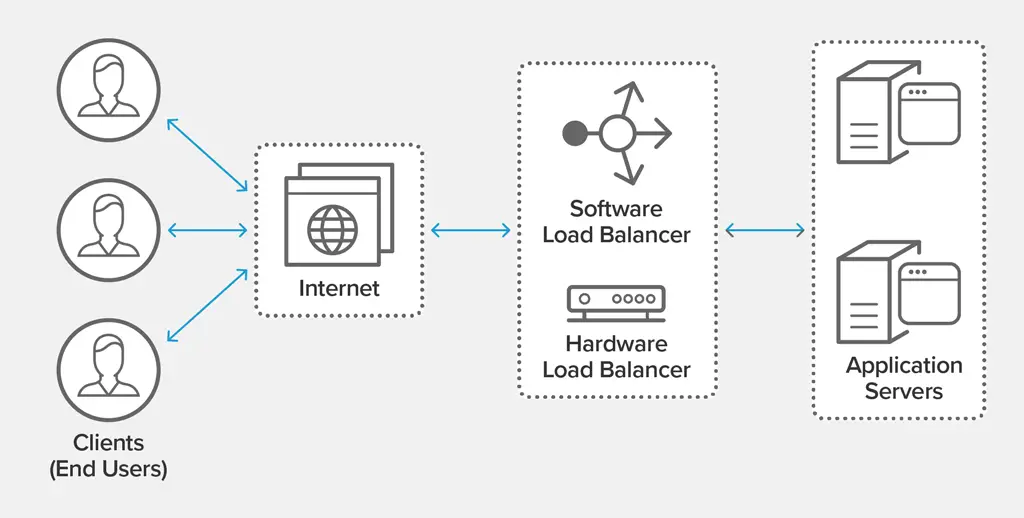Optimizing Streaming Performance with CDN Load Balancing

Introduction:

Content Delivery Networks (CDNs) enhance streaming performance by distributing content across multiple servers worldwide. To maximize efficiency, it’s crucial to implement load balancing to distribute traffic evenly and ensure optimal performance.

Types of Load Balancing Techniques:
- DNS Load Balancing: Redirects traffic to different servers based on DNS records.
- Layer 4 Load Balancing: Routes traffic based on IP address and port information.
- Layer 7 Load Balancing: Analyzes traffic at the application level, considering factors like bandwidth and latency.
Choosing the Right Load Balancing Technique:
- DNS Load Balancing: Suitable for simple streaming scenarios with static content.
- Layer 4 Load Balancing: Ideal for balancing high-volume traffic, but less granular than Layer 7.
- Layer 7 Load Balancing: Provides the most flexibility and control, allowing for advanced traffic management.
Best Practices for Load Balancing:
- Health Monitoring: Regularly check server health to identify and remove unhealthy instances.
- Capacity Planning: Estimate traffic load and allocate sufficient capacity across servers.
- Geographic Distribution: Place servers in multiple locations to minimize latency and improve responsiveness.
- Traffic Analysis: Monitor traffic patterns to identify bottlenecks and adjust load balancing configurations.
- Failover and Redundancy: Implement failover mechanisms to ensure seamless streaming in case of server outages.
Benefits of Effective Load Balancing:
- Improved Performance: Reduces latency, jitter, and buffering, enhancing viewer experience.
- Increased Scalability: Allows streaming platforms to handle large traffic surges effectively.
- Cost Optimization: Distributes traffic intelligently, minimizing server costs and optimizing resource utilization.
- Enhanced Reliability: Failover mechanisms ensure uninterrupted streaming even during server outages.
- Improved Content Delivery: Delivers content from the nearest server, reducing latency and improving overall user satisfaction.
Conclusion:
CDN load balancing is essential for optimizing streaming performance. By implementing the right load balancing technique and following best practices, streaming platforms can maximize their efficiency, ensure reliability, and deliver a seamless viewing experience to their audience.# Achieving Optimal Streaming Performance With CDN Load Balancing
Executive Summary
Content delivery networks (CDNs) are essential for delivering high-quality streaming experiences to users around the world. By distributing content across a network of servers, CDNs can reduce latency, improve reliability, and enhance the overall user experience. However, managing CDN traffic can be a complex task, especially during periods of high demand. CDN load balancing is a critical tool that can help to optimize CDN performance and ensure that users have a seamless streaming experience.
Introduction
Streaming media has become an integral part of our lives. We stream movies, TV shows, music, and even live events on a daily basis. In order to provide a high-quality streaming experience, it is essential to have a reliable and efficient content delivery network (CDN). A CDN is a network of servers that store and deliver content to users around the world. By distributing content across multiple servers, a CDN can reduce latency, improve reliability, and enhance the overall user experience.
FAQs
What is CDN load balancing?
CDN load balancing is the process of distributing traffic across multiple CDN servers. This helps to ensure that all users have a fast and reliable streaming experience, even during periods of high demand.
What are the benefits of CDN load balancing?
CDN load balancing offers a number of benefits, including:
- Reduced latency
- Improved reliability
- Enhanced scalability
- Increased security
How does CDN load balancing work?
CDN load balancing works by using a variety of algorithms to distribute traffic across multiple CDN servers. These algorithms take into account a number of factors, such as the server load, the user’s location, and the content being requested.
Key CDN Load Balancing Subtopics
1. Load Balancing Algorithms
Load balancing algorithms are the core of any CDN load balancing solution. These algorithms determine how traffic is distributed across the network of CDN servers. There are many different load balancing algorithms available, each with its own advantages and disadvantages. Some of the most common load balancing algorithms include:
- Round-robin: This algorithm distributes traffic evenly across all available CDN servers.
- Weighted round-robin: This algorithm assigns different weights to each CDN server, allowing more traffic to be directed to the servers that can handle it.
- Least-connections: This algorithm sends traffic to the CDN server with the fewest active connections.
- Least-time: This algorithm sends traffic to the CDN server that has been idle for the longest period of time.
2. Server Health Monitoring
In order to ensure that all CDN servers are healthy and available, it is important to monitor their health. This can be done by using a variety of tools and techniques, such as:
- Ping: This tool sends a packet to a CDN server and measures the time it takes for the server to respond.
- Traceroute: This tool traces the route of a packet from the user’s device to the CDN server. This can help to identify any potential bottlenecks or issues that could affect performance.
- Uptime monitoring: This tool monitors the uptime of CDN servers and alerts you if a server goes down.
3. Content Caching
Content caching is a technique that can be used to improve the performance of a CDN. By caching popular content on CDN servers, you can reduce the number of requests that need to be sent to the origin server. This can lead to faster load times and a better user experience.
4. Geolocation
Geolocation is the process of determining the user’s location. This information can be used to direct traffic to the CDN server that is closest to the user. This can help to reduce latency and improve the overall streaming experience.
5. Security
Security is an important consideration for any CDN load balancing solution. It is important to ensure that the CDN network is protected from DDoS attacks and other security threats. This can be done by using a variety of security measures, such as:
- Firewalls: Firewalls can be used to block unauthorized access to the CDN network.
- Intrusion detection systems (IDS): IDS can be used to detect and block malicious traffic.
- DDoS mitigation: DDoS mitigation solutions can be used to protect the CDN network from DDoS attacks.
Conclusion
CDN load balancing is a critical tool for optimizing the performance of a CDN. By using a CDN load balancing solution, you can ensure that all users have a fast and reliable streaming experience, even during periods of high demand.
Relevant Keyword Tags
- CDN load balancing
- Streaming performance
- Content delivery networks
- Load balancing algorithms
- Server health monitoring
